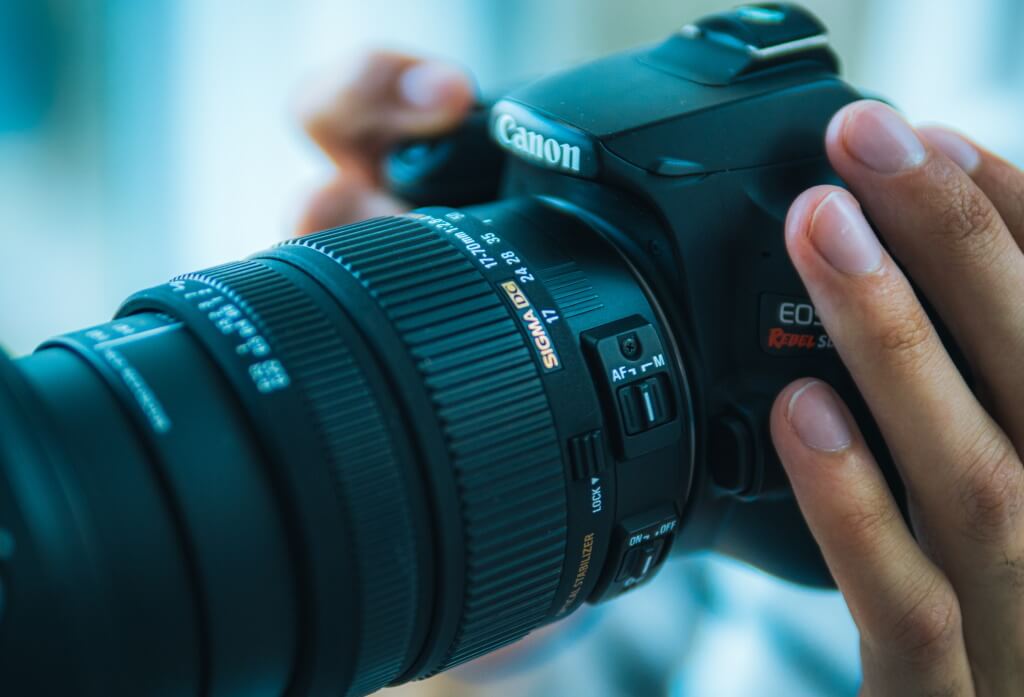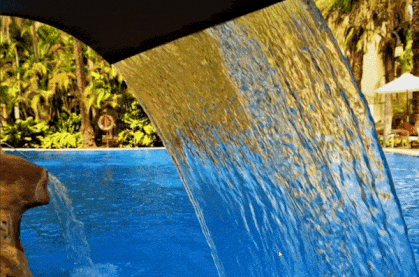Modern digital cameras usually have two distinct Autofocus systems: the traditional AF you get through the optical viewfinder; and (usually) a separate AF system for focus using the LCD monitor to view your scene, when shooting with Live View or recording video.
-
Viewfinder AF:
Usually relies on a separate AF sensor for focus detection, and always uses what’s called Phase Detection technology.
-
Live View and video AF:
Uses pixels on the imaging sensor to read focus information. Early systems simply read blurriness or sharpness of the image sensor; this is called Contrast Detection AF.
Dual Pixel CMOS AF utilizes individual pixels, or groups of pixels, on the image sensor and makes comparisons of data to detect when a subject is focused or not.
Canon autofocus systems Types
Now let us discuss the various types of autofocus systems:
-
Contrast Detection autofocus
Contrast detection is the simplest, most accurate method of autofocus technology. In addition, it’s the cheapest autofocus technology.
The camera looks at the contrast between edges in your scene and moves the focus motor until the contrast is the sharpest. At first, the camera goes back and forth with large adjustments, and then smaller refinements until it got the sharpest photo. When the autofocus motor “hunts” back and forth, doing the same thing as you would do when manually focusing; this is contrast detection at work.
Contrast detection is exceptionally accurate, since it analyses every point of contrast, pixel by pixel, on the camera’s sensor. Naturally, that process is time-consuming, which means it is also a slow way of autofocusing.
Contrast detection autofocus will give you the most accurate focus when shooting single-shot autofocus with a still subject and high-contrast scenes.
Contrast detection autofocus is not good with moving objects because of the time it takes to find the maximum contrast. By the time, that maximum contrast point is detected, the subject has already moved to a different distance, and the camera must find that position again.
-
Traditional Phase detection autofocus
Phase detection technology separates the light entering the camera into two separate beams. When the two parts converge, the image is in focus. When they don’t line up, the system makes precise changes to the focus motor to align the images.
Most modern DSLR cameras have a dedicated AF sensor that reads the light entering the lens. Mirrorless cameras don’t have a dedicated autofocus sensor but take readings from the main sensor.

A small portion of light goes through the main mirror and is reflected by the secondary mirror, as illustrated above). Next, the light reaches the Phase Detect / AF Sensor, which redirects it to a group of sensors (two sensors per AF point). The camera then analyzes and compares images from these sensors and if they do not look identical, it instructs the lens to make proper adjustments.
Here is what happens when a camera acquires focus on a subject:
- The two-image sensors evaluate the light that passes through the extreme sides of the lens. the AF system determines if an object is front or back focused and by how much
- The AF system then instructs the lens to adjust its focus.
- Once perfect focus is achieved, the AF system sends a confirmation that the object is in focus (a green dot inside the viewfinder, a beep, etc)
The above is repeated as many times as needed until perfect focus is achieved.
The first EOS cameras used a single AF sensor or focus point. This sensor was positioned to focus the lens on a subject in the center of the viewfinder image. Starting in 1990, EOS cameras have multiple focusing points. A number of AF sensors are positioned across the image area, each taking a reading from a different part of the scene.
These days even an entry-level DSLR has an autofocus sensor with several AF points. The EOS 4000D, for example, has 9 points, and the flagship EOS-1D X Mark III has 191 points. Some of these points are made up of two line sensors that create a cross, which is sensitive to both horizontal and vertical detail.
The below photo shows A diagram of a sensor with 45 AF points with vertical line sensors and Cross-type sensors.

The Phase detection autofocus system is very well suited for action photography. It works best when used with image tracking and AI/AF Servo/Continuous Focus modes.
It works for other types of photography too, such as portraits and still life. However, action photographers will be the most grateful for the inclusion of this system.
There are several other advantages of phase detection autofocus:
- Instant focus response, to drive the lens in the proper direction
- Very little tendency to “hunt” back and forth to find the sharpest focus
- Ability to continually update AF, on a shot-by-shot basis, to follow moving subjects
- Not only does the AF system know the direction to focus the lens, and have the ability to follow moving subjects, but it adds the ability to predict the degree of subject movement in the instant that occurs before focus detection ends. Canon calls this predictive focus element “AI Servo AF”
-
Dual Pixel CMOS AF
Canon’s Dual Pixel CMOS AF system was introduced in the EOS 70D in 2013. The latest version of this, Dual Pixel CMOS AF II, was introduced in 2020 in the Canon EOS R5 and EOS R6.
Each pixel on the Dual Pixel CMOS sensor has two independent photodiodes (the parts of the sensor that record light intensity or brightness).

The camera’s processor compares the signals from the two photodiodes, and if they match, it knows that this area of the image is in focus. If there is any deviation between them, it looks at pairs of photodiodes across a group of pixels, and can then calculate which direction the lens needs to be adjusted to achieve sharp focus, and how much focus adjustment is required.
In this way, Dual Pixel CMOS AF phase-detection focusing usually requires less trial-and-error and is more effective than contrast detection.
The Dual Pixel CMOS AF system has the following main Features:
- The AF system covers the entire image sensor, not just a limited number of AF points. Every pixel in the sensor can be used for both imaging and AF, ensuring sharpness right across the frame and enabling an astonishing number of selectable AF points.

- Dual Pixel CMOS AF is able to provide smooth, continuous Servo AF, for moving subjects.
- It is optimized for the different needs of both still and video shooting.
Advanced features in autofocus systems
The intelligent autofocus system with deep learning algorithms is originally developed for the Canon EOS-1D X Mark III, it is also present in the EOS R3, EOS R5, EOS R6, EOS R7 and EOS R10.
The system is based on an algorithm that teaches itself by scanning millions of images. The system essentially learns how to recognize the heads of people, even if they’re skiers wearing goggles, racing drivers wearing helmets, gymnasts upside down or even facing away from the camera. Deep learning is a huge leap forward from the intelligent autofocus systems of previous Canon cameras.
-
Face Detect, Tracking, and Eye Detect AF
Further developments in face recognition capability have enabled the introduction of Face Detect, Tracking, and Eye Detect AF on mirrorless EOS cameras and recent DSLRs in Live View mode.

In this mode, the camera uses artificial intelligence to help it find faces in the scene, and if eye detection is enabled, it can find eyes in the scene and focus on the one that is selected.
-
Subject tracking
The most recent Canon cameras use deep-learning artificial intelligence, trained using thousands of images of objects in the real world, to enable them to recognize specific subjects wherever they are in the frame. The subject can be set to people, animals or vehicles.

Photo by Daniel
The cameras are even able to track people when they are wearing a mask, helmet, or sunglasses, and when the subject to detect is set to Vehicles, the cameras can identify and track motorbikes and racing cars.

Vehicle AF enables the photographer to concentrate on the timing and composition while the camera takes care of spotting the racing car or motorbike in the frame and making sure it is in focus as it moves through the frame.
Animal Detection and Animal Eye AF make capturing great images of dogs, cats, and birds much easier because when these are activated, the camera automatically detects animals and prioritizes their eyes for focusing.

Photo by Couleur
-
Eye Control AF
Autofocus speed and convenience are taken to the next level with the Eye Control AF system in the EOS R3. The system uses an array of infrared LEDs to monitor the position of your eye as you look through the viewfinder, and can use this to set or switch the AF point according to what you’re looking at when you choose to engage the feature. Once it has acquired the subject, it can take over and start tracking that subject.

Photo by Canon
Video by Canon
Autofocus operation modes
Most EOS cameras offer two different autofocusing modes:
-
One-shot AF
One-shot AF mode suits most subjects that stay in one place while you take a photograph (still subjects). The focus is locked with the first pressure on the shutter button.
-
AI Servo AF
AI Servo AF mode is designed for moving subjects. The camera calculates where the subject will be at the moment the shutter fires and focuses the lens accordingly.
AI Servo AF does not utilize focus lock as One-Shot AF does. It continually checks the focus and refocuses the lens each time the camera-to-subject distance changes, right up to the moment of exposure. This makes it ideal for photographing moving subjects − you can retain partial pressure on the shutter button as you follow the subject with the camera, applying full pressure to take a picture at the key moment.
AF method (AF Area)
- Face Tracking – including, in the latest cameras, bird and animal tracking. On some cameras, this appears as a separate Subject tracking menu option.
- 1-point AF – the camera focuses using a single AF point;
- Spot AF – the camera focuses using an even smaller area than 1-point AF;
- Expand AF area – there are two options here. With either, the camera focuses using a single AF point, but if it is unsure then it uses another AF point to assist or may switch to that point instead. Both of these are effective with moving subjects, which are difficult to track with 1-point AF;
- Zone AF – uses auto-selection AF within a larger area, optionally focusing on the nearest subject or using various criteria such as faces, subject motion, and subject distance.
Related Posts
What Is Autofocus And How It Work
Manual Focus In Digital Camera- Manual Focusing Vs Autofocusing
Thanks for reading, I hope you enjoyed the article, in case you have any questions just drop them below & I will be happy to answer you.
The featured Photo by Maxime Doré on Unsplash
If you enjoy the site, don’t forget to subscribe, we will only inform you when a new article is posted.










I am really interested in purchasing a nice camera. I am terrified though of not being able to use it properly or to it’s full potential, or know how to make adjustments to settings as needed. I like the term “auto focus”, LOL To me that sounds like less work for me, and more that the camera is doing on it’s own! Are there courses you can take once you do get a nice camera to be able to use it properly?
Of Course, there are lots of photography courses on the market, you may check the following posts:
Learn Digital Photography Online contains
a round-up of some of the best online photography courses that will teach you everything you need to know. In addition, the second one is YouTube Photography Tutorials- Improve Your Photography Skills, in this post, I compiled a list of my favorite YouTube channels that I found very interesting and useful.
Thanks for the comment
Many thanks for this valuable and detailed post about Canon Autofocus Systems. I don’t know much about these things. So, if I take a photo most of the time, I use autofocus. So with this post I can improve it further. Keep posting like this. I will definitely share this with my friends.
Thanks for the comment